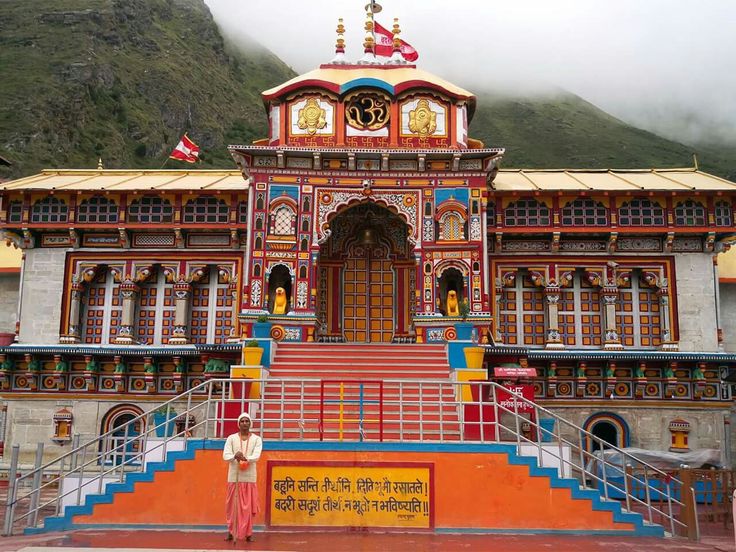Badrinath Temple: The Divine Sanctuary and Its Powerful Significance
Introduction
Nestled in the serene and majestic Himalayan mountains, the Badrinath Temple in Uttarakhand is one of the most revered pilgrimage sites in India. As a part of the Char Dham Yatra, Badrinath has been a center of spiritual significance for centuries, drawing devotees from all corners of the world. Dedicated to Lord Vishnu, this sacred temple not only holds immense spiritual value but also offers a glimpse into India’s rich cultural and religious heritage. In this article, we will explore the history, significance, and daily life impacts of Badrinath, helping you understand why it remains a beacon of divine light.
1. History and Origins of Temple
The origins of the Badrinath Temple are steeped in mythology and tradition. According to ancient texts, Lord Vishnu, one of the principal deities in Hinduism, meditated at this very location to attain eternal peace. The place was once covered with dense forests of badri (berry trees), which is why it was named Badrinath, meaning “the Lord of the Berry Tree.”
The temple’s history dates back to ancient times, and it is believed that it was originally constructed by Adi Shankaracharya in the 9th century. Over the centuries, the temple has undergone several reconstructions, with the current structure being built in the 19th century. Despite facing challenges such as natural calamities and invasions, Badrinath has stood resilient, continuing to be a hub of spiritual worship.
2. The Spiritual Significance
It is one of the Char Dhams (four pilgrimage destinations) that every devout Hindu aspires to visit. This temple holds special significance as it is dedicated to Lord Vishnu, the preserver of the universe in Hindu mythology. It is believed that a visit to Badrinath ensures liberation (moksha) from the cycle of birth and rebirth. The temple is said to be a gateway to attaining eternal peace and spiritual awakening.
It is not only significant for Hindus but is also known for its divine energy that resonates with people of all faiths. The temple’s location, surrounded by snow-capped mountains, adds to the overall spiritual experience, offering a sense of divine connection with nature. For many devotees, the Badrinath Yatra is an essential spiritual journey, and its significance is immeasurable.
3. Daily Life and Rituals
A visit to Badrinath offers an enriching and spiritual experience. The temple opens only for six months of the year, from April to November, due to the harsh weather conditions in the region. During this time, the temple is a vibrant center of worship and devotion.
The daily rituals at Badrinath are filled with reverence and grace. The temple opens at 4:30 AM with the Mangal Aarti (morning prayer) to awaken Lord Vishnu. This is followed by other rituals, including the Abhishek (bathing of the deity) and offering of prasad (sacred food). The temple follows a schedule of aarti and worship throughout the day, with the Shayan Aarti (night prayer) marking the closing of the temple in the evening.
Devotees flock to the temple to offer prayers, seeking blessings for prosperity, good health, and peace. A visit to the temple is considered a purification of the soul, and many pilgrims complete the Char Dham Yatra by visiting Badrinath as the final destination.
4. Impact of Temple on Daily Life
The daily life impact of Badrinath can be felt by those who visit the temple for worship. Many devotees report that the experience of being in Badrinath brings a sense of peace, tranquility, and inner strength. The sheer beauty of the surrounding landscape, combined with the powerful presence of Lord Vishnu, leads to a deep spiritual awakening.
The physical journey to Badrinath, often a challenging trek through the rugged mountains, symbolizes the spiritual journey of life itself. The hardships encountered during the trek are seen as a way of purifying the mind and body, while the destination offers solace and divine blessings.
For many, the rituals and prayers performed at the temple help them attain mental peace and clarity. The temple environment fosters a sense of belonging and community among the pilgrims, further enhancing the spiritual experience.
5. The Societal Importance
Beyond its religious and spiritual significance, the Badrinath Temple plays a vital role in society. The temple is a major economic contributor to the region, as it attracts millions of pilgrims and tourists every year. This influx of visitors boosts the local economy, creating job opportunities and fostering development in the area.
The presence of the temple has also preserved and promoted the cultural heritage of the region. The rituals, festivals, and practices followed at Badrinath are integral to the cultural identity of Uttarakhand and India as a whole. The temple serves as a bridge between ancient traditions and the modern world, preserving the essence of spiritual practices and teachings for future generations.
6. Key Facts About Temple
- Location: Badrinath Temple is located in Uttarakhand, India, at an altitude of 3,133 meters (10,279 feet) above sea level.
- Dedicated to: Lord Vishnu, the preserver in Hindu mythology.
- Opening time: The temple opens for devotees from April to November.
- Aarti Schedule: The Mangal Aarti takes place early in the morning, and the Shayan Aarti marks the temple’s closure in the evening.
- Significance: A visit to Badrinath is considered an essential part of the Char Dham Yatra, and it is believed to bring blessings of peace, prosperity, and moksha (liberation).
7. FAQs Temple
- What is the best time to visit Badrinath Temple?
The best time to visit is during the summer months, from May to October, when the weather is pleasant and the temple is open for visitors. - How can I reach Badrinath Temple?
Badrinath is well-connected by road. The nearest airport is Jolly Grant Airport in Dehradun, about 314 km away. The nearest railway station is Rishikesh, which is approximately 297 km from Badrinath. Pilgrims typically take buses or taxis from these points. - Is Badrinath Temple open year-round?
No, the temple is open only for six months, from April to November. It closes for the winter due to heavy snowfall and harsh weather conditions. - What should I wear when visiting Badrinath?
Visitors are advised to wear warm and comfortable clothing, especially during the colder months, as the altitude can make the weather chilly even in summer. - Can non-Hindus visit Badrinath Temple?
Yes, the temple welcomes visitors of all faiths. While it is primarily a Hindu temple, people from different backgrounds are invited to witness its beauty and spiritual atmosphere.
Conclusion
The Badrinath Temple stands as a monumental symbol of devotion, spiritual awakening, and the divine presence of Lord Vishnu. With its breathtaking surroundings, rich history, and deep significance, it continues to inspire countless devotees to embark on a journey of faith, resilience, and inner peace. For those seeking spiritual solace, Badrinath offers an unparalleled experience, one that transcends mere physical pilgrimage and resonates deeply with the soul.










